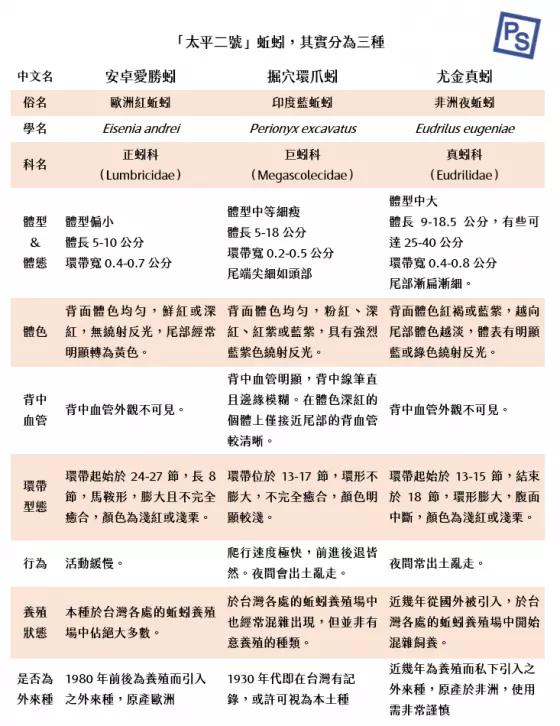Decryption of red earthworms cultured in Taiwan
To explore the secret of Taiping No. 2, which is called "jianghu nickname".
There are two kinds of Si, and there are three kinds in Taiping II.

As mentioned above, everyone says that Taiping No. 2 is an earthworm. It sounds like Taiping No. 2 is a pure variety bred under an earthworm species. It is as accurate as the names of "Tainong 71", "Persian Cat" and "Chai Dog". But it seems that the breeding of red earthworms everywhere is not even a pure "species", not even a pure "species". Among the piles of earthworms known as "Taiping II" picked up in local farms, there is actually more than one species at all. at present, there are as many as three species, and not all of them are called red earthworms.
Some people may think that no matter how many kinds of earthworms they are, they will eat food waste, turn over compost, or eat animals as feed. Yes, if it's just such a simple requirement, it doesn't matter if there are 30 possibilities in the farm. However, if we really hope that the earthworm farming industry can be more refined, and the earthworms raised can have more delicate niches and uses, then it should be a better trend to find out the differences between the earthworms on their hands, and to raise each species separately if possible, and to provide the best culture environment for a variety of needs and functions, and to use them in the most appropriate way.

The three kinds of earthworms in the so-called "Taiping II" lie in rows. Do you see the difference?
What's more, the three species of earthworms raised in Taiwan are not just different species like Pomeranian, fox dog and Chihuahua, or just similar species of the same genus, such as orange, willow, and grapefruit. The three species of earthworms cultivated in Taiwan are Android Eisheng worm (Eisenia andrei), burrowing ring claw worm (Perionyx excavatus), and Eugene worm (Eudrilus eugeniae).
Moreover, these three kinds of earthworms belong to different families, that is to say, the differences between them are as big as "cat", "dog" and "raccoon"!
Therefore, if you just want to collect feces and mix these three kinds of animals with "hairy, four feet, tails, and all eat meat" together, it certainly doesn't matter. However, if you want to "catch mice" or "housekeeper", or even want to provide the least food but collect the most feces, find out what kind of animals you are raising, and pick out the most suitable species, it's better.
Here is a comparison table of these three kinds of earthworms:
The difference of three kinds of "Taiping II".

- Prev

Analysis on the present situation and Countermeasures of Carp Culture
1 the morphology and characteristics of carp belong to Cyprinidae. Carp are flattened and hypertrophic on the side, fusiform and up to 120cm in length.
- Next

The cultivation methods and precautions of golden branches and jade leaves
Jinzhiyuye, scientific name purslane tree, is an evergreen succulent plant. The leaves of Jinzhiyuye are small, but oily and shiny, fleshy, and grow very happy...
Related
- On the eggshell is a badge full of pride. British Poultry Egg Market and Consumer observation
- British study: 72% of Britons are willing to buy native eggs raised by insects
- Guidelines for friendly egg production revised the increase of space in chicken sheds can not be forced to change feathers and lay eggs.
- Risk of delay in customs clearance Australia suspends lobster exports to China
- Pig semen-the Vector of virus Transmission (4)
- Pig semen-the Vector of virus Transmission (3)
- Five common causes of difficult control of classical swine fever in clinic and their countermeasures
- Foot-and-mouth disease is the most effective way to prevent it!
- PED is the number one killer of piglets and has to be guarded against in autumn and winter.
- What is "yellow fat pig"? Have you ever heard the pig collector talk about "yellow fat pig"?

